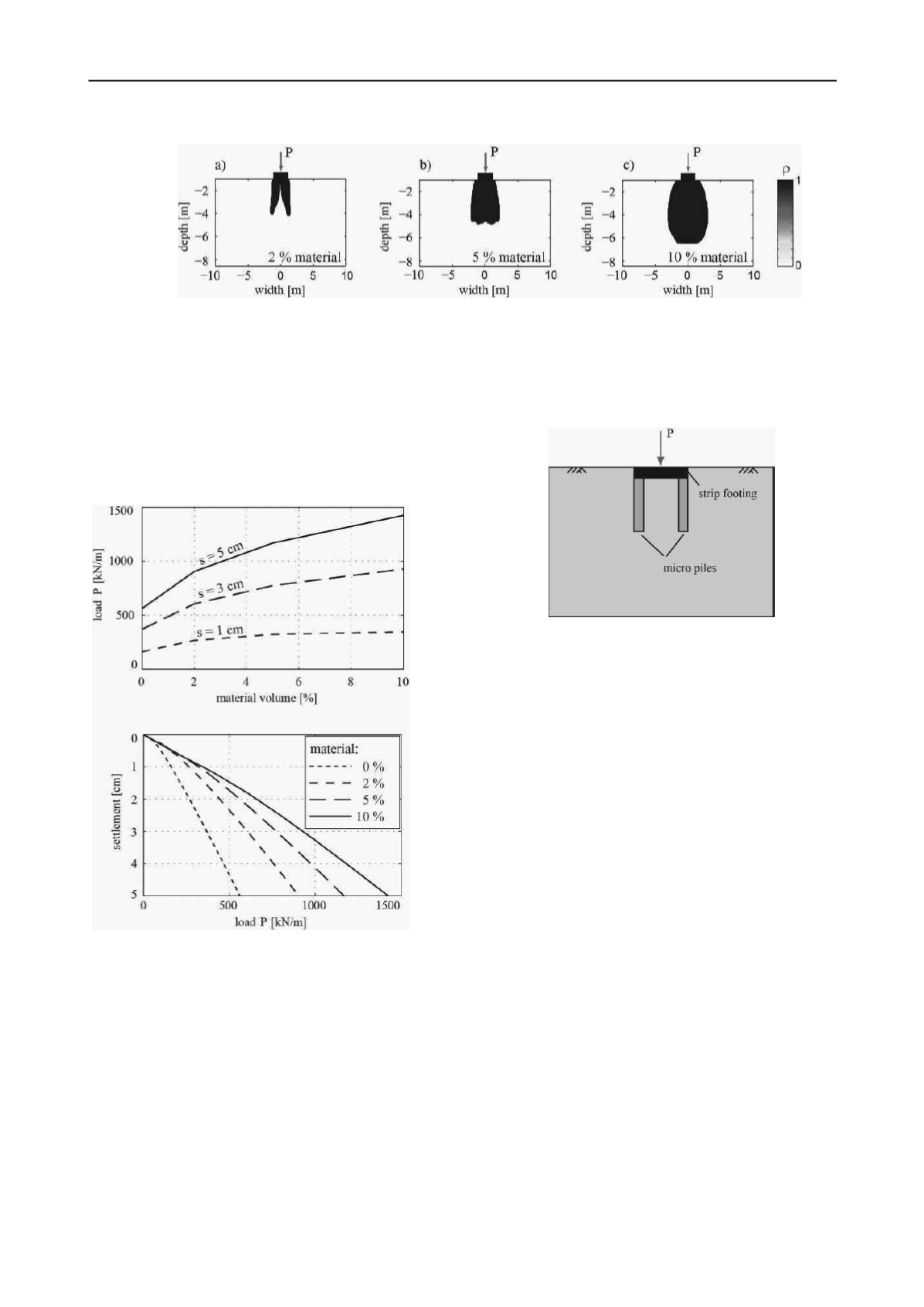
2090
Proceedings of the 18
th
International Conference on Soil Mechanics and Geotechnical Engineering, Paris 2013
Proceedings of the 18
th
International Conference on Soil Mechanics and Geotechnical Engineering, Paris 2013
The influence of the material volume on the improvement is
shown in Figure 8. Figure 8 top shows the material volume over
the vertical load P at different settlements. The applicable load
at a settlement restriction about 1 cm cannot be significantly
improved using more than 2% material volume. Regarding
higher settlement restrictions, the increase of the material
volume also increases the applicable load P.
The same results can be obtained from the load settlement
curves of the improved foundations in Figure 8 bottom. The
main improvement is reached with a material volume about 2%.
1.5
Practical realization
The practical realization of the optimized topologies can be
quite difficult. The optimized topologies of the presented
example can be realized using the jet grouting method. This
method allows the realization of every possible topology
restricted by the minimum diameter of a jet grouting body.
Another possibility to realize such topologies is the
interpretation of the topologies and the conversion of the
topology into standard geotechnical construction parts. The
realization of the topology with 2% material can be done using
a classical strip foundation topology in combination with micro
piles, see Figure 9.
2 CONCLUSION
The application of topology optimization in geotechnical
engineering was presented. The applied SIMP-Method is
suitable for geotechnical problems. In the presented example,
the settlements of a strip foundation could be reduced up 66%.
Topology optimization in geotechnical engineering has a
great potential and can lead to innovative and efficient designs.
3 REFERENCES (TNR 8)
Allaire G., De Gournay F., Jouve F. And Toader A.-M. 2005. A level-
set method for shape optimization.
Controal and Cybernatics
34.
Bendsøe M.P. 1995. Optimization of structural topology, shape and
material. Berlin, Heidelberg, New York
Grabe J., Kinzler S., Pucker T. And Mardfeldt B. 2010. Untersuchung
des Tragverhaltens und der Anwendbarkeit numerischer
Optimierungsverfahren für Kaikonstruktionen.
Tagungsband der
31. Baugrundtagung 2010 in München,
123-129
Grabe J., Pucker T., Busch P. 2012. Non-linear numerical model for the
design process of deep foundations with regard to effects of pile
installation.
Proceedings of 9th International Conference on
Testing and Design Methods for Deep Foundations 2012 in
Kanazawa/Japan,edited by T. Matsumoto
, 55-64
Kinzler S. 2007. Entwurf einer Pfahlgründung unter Anwendung der
Mehrkriterien-Optimierung.
Der Bauingenieur
82, 367-379.
Sigmund O. 2001. A 99 line topology optimization code written in
Matlab.
Structural and Multidisciplinary Optimization
, 21, 120-127
Niemunis A. and Herle I. 1997. Hypoplastic model for cohesionless
soils with elastic strain range.
Mechanics of Frictional and
Cohesive Material
, 2, 279-299
Pucker T. and Grabe J. 2011. Structural optimization in geotechnical
engineering - basics and application.
Acta Geotechnica
, 6, 41-49,
DOI: 10.1007/s11440-011-0134-7
Von Wolffersdorff P.-A.. 1996. A hypoplastic relation for granular
materials with predefined limit state surface.
Mechanics of
Frictional and Cohesive Material
, 1, 251-271
Figure 7. Optimized foundations with a) 2% material volume, b) 5% material volume, c) 10% material volume
Figure 8. top: load P over material volume at different settlement
restrictions; bottom: load-settlement curves of the optimized foundation
topologies
Figure 9. Possible practical realization of the topology with 2% material
volume


